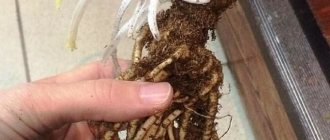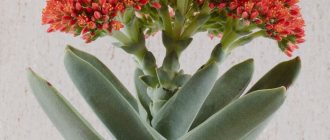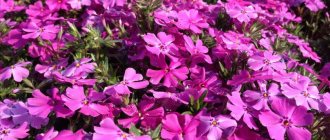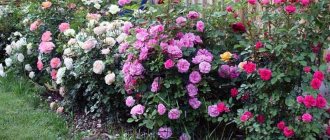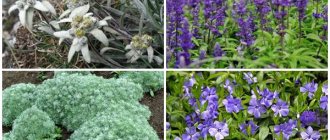Poetic narcissist
The natural habitat of this variety is mountainous areas with the presence of water sources such as lakes and rivers. First bred in 1538 near the Mediterranean Sea. The plant is characterized by accelerated growth and abundant flowering. Important conditions are sufficient humidity and direct sunlight on the leaves.
In adulthood, the daffodil can reach half a meter in height. Reproduction occurs using spherical or ovoid bulbs. One bush produces about five long and flat leaves of a rich green color. The inflorescences bloom one by one, the color is white, the heads are directed towards the ground. In the center of the flower there is a yellow crown with a bright outline. The diameter can reach 6 cm, and its stem often outgrows the height of the leaves.
The awakening of the bulbs occurs in early spring. After this, active growth of the plant occurs and already in May the narcissus pleases with its flowering, which lasts up to 12 days. If the frost drops below -10 degrees, protection in the form of an improvised shelter will be required. Otherwise, freezing may occur.
Small-cupped daffodils
In these single flowers, the length of the crown is less than 1∕3 the length of the petals. Most small-crowned daffodils have white, yellow or cream-colored petals, and the crown can be yellow-orange, apricot, pink, red or greenish, often with a darker border.
Small-crowned daffodils bloom later than plants from the first and second groups, but they are highly valued for their abundant flowering, rapid growth and delicate aroma of flowers.
Popular varieties:
- Amor (white with a large orange-red crown),
- Audibon (white with creamy pink crown),
- Rockall (white with red crown),
- Edward Buxton (yellow with a greenish-yellow crown and orange border).
yellow daffodil
The species and varieties of daffodils shown in the photo are distinguished by their yellow inflorescence. The first appearance of the plant dates back to 1500; it was brought to our region from France, Italy and Germany. In the wild, it thrives on the slopes of the Caucasus Mountains.
This daffodil grows small - up to 30 cm. Reproduction occurs in round (sometimes oval) bulbs, about 5 cm in diameter. The stem with the flower grows higher than the leaves; when open, the petals reach a diameter of 4 cm. The core is shaped like a crown, the edge of which has a corrugated structure. Flowering begins on the 15th of May and lasts 14 days.
During the rapid growth phase, the plant produces dark green buds that will eventually end up 10cm below the flowers. Many other types of daffodils have been bred from this variety. They are used to decorate personal plots and gardens with rocky soil. Usually planted as neighbors for tulips, royal crowns and other mixed plantings, in which juniper occupies a central place.
Planting narcissus in open ground
Soil for daffodil
The main requirement for the soil in which daffodils will be grown is fertility and good moisture holding capacity. As for the soil pH, the acceptable range for daffodils is from slightly alkaline to slightly acidic - 6.5-4.9 pH. Neutral loam fertilized with compost or humus, but not manure, best suits the tastes of daffodils: this organic fertilizer can only be applied to the crop preceding the daffodils. Wet and calcareous soils are considered unsuitable for growing daffodils. You cannot plant daffodils where tulips , lilies and other bulbous perennials, as well as asters , phlox and chrysanthemums . But peonies , cucumbers , legumes, cereals and nightshade crops are the best predecessors for daffodils. Daffodils are photophilous, so the area should be well lit by the sun. Flowers can grow in one place for three to five years.
About six months before planting, the site is dug up to the depth of a spade with humus or compost (5-8 kg/m²). If necessary, sand is also added to the soil. As for mineral fertilizers, they are applied two weeks before planting, using 60 g of Nitrophoska for each m² of plot.
When to plant daffodils
Traditionally, bulbous crops are planted in the garden in the fall: in the middle zone - in August-September, in the southern regions - in September-October, and sometimes even in November. The period is set based on the fact that the bulb needs 3-4 weeks to take root. If you decide to plant daffodils in the spring, you will have to stratify the planting material for two months in the vegetable drawer of the refrigerator, otherwise rooting may be complicated, and problems with flowering may arise in the future. Narcissus bulbs that have undergone stratification are planted in the flowerbed from mid to late April, when the soil temperature rises to 5-7 ºC.
Planting daffodils in the ground
Before planting, the bulbs are inspected and those that show damage or signs of disease are discarded. Soft bulbs are also not suitable for planting. Healthy material is disinfected for half an hour in a one percent solution of potassium permanganate or in a three percent solution of Fundazol.
Daffodils need to be planted in holes with a depth equal to three times the diameter of the bulb: pour a handful of sand and a couple of tablespoons of wood ash into the planting hole, lay the bulb on the sand, fill the hole halfway with soil, water and complete the planting by filling the remaining space with soil. The distance between the holes depends on whether you intend to grow daffodils in this place for a long time or plant them in a year. In the first case, the distance should be at least 15 cm, and in the second, an interval of 7-10 cm will be sufficient.
White daffodil
This flower continues the list of types of daffodils (with photos and names). It was developed as a crop in 1579 and brought from the Iberian Islands. In the wild it can be found in mountainous areas with a lot of grass cover. In adulthood, the plant reaches a height of 35 cm. Reproduction occurs by spherical bulbs with a diameter of 4 cm. The leaves are similar to the varieties described above, the peduncle does not grow higher than 23 cm.
The flower itself is completely white. Unlike the poetic daffodil, here the inner crown is the same color, without a pronounced outline. The active growth phase begins in mid-spring, and flowering occurs at the end of May. The flower blooming period lasts no more than 10 days.
Types and varieties
Daffodils of different varieties are sometimes so different in appearance that by planting several varieties of these flowers on your site, you can get a bright, picturesque, multi-colored flower bed. In addition, different varieties bloom at different times (with an interval of 2-3 weeks), so your daffodil bed can bloom for a very long time.
Daffodil flowers are simple and double, have different flower structures (holly, crown-shaped, tubular, cyclamen-shaped) and are represented by all sorts of variations of yellow-white colors. Breeders continue to develop varieties with more and more differences. It was precisely this all possible combination of different characteristics that gave such a variety of daffodil varieties.
- Hydrangea paniculata: planting, care, description of varieties
More than 60 natural species of daffodils are known alone, and there are also hundreds of varieties and hybrids. And there are thousands of selective daffodils - about 35,000 varieties and hybrids.
Therefore, there was a need to create an International Classification of Daffodils, which divides flowers into 13 groups: Trumpet, Large-cupped, Small-cupped, Double, Triandrus, Cyclamineus. , Jonquilla, Tazetta, Bunch-flowered, Poeticus, Bulbocodium Hybrids, Split-Corona, Others, Allspecies.
The last two groups are daffodils obtained by crossing hybrids of different groups.
Daffodils are also divided according to the timing of flowering into early-, mid- and late-flowering (flowering may depend on the planting of daffodils, or more precisely, the time of planting). In all this diversity, you will definitely find those varieties that will not leave you indifferent and with which you will be happy to decorate your garden.
Narcissus Tete-a-Tete
This variety of narcissus belongs to the cyclamen type. It was developed as a separate crop in 1585. The height of the plant does not exceed 25 centimeters. There is one flower on the flower stalk, which is very different from other types: the petals are sharply directed upward, while the bud itself and the inner crown are lowered down. Color – bright yellow.
Flowering begins in early May, which is earlier than other varieties. The aroma of the flower is pleasant. When caring, it is important not to let the soil dry out too much, since this daffodil does not tolerate drought. Usually planted near borders or low fences. Able to quickly increase its numbers by releasing new bulbs in the shape of a ball. During winter, the plant is dug out of the ground and stored in the basement until the weather warms up.
Possible problems in growing
Problems with leaves
If watered incorrectly, they begin to turn yellow and break. If you continue to care for it incorrectly, the flower will dry out completely.
Pests:
- Nutcrackers;
- Onion hoverfly;
- Root mite;
- Cabbage scoop;
- Medvedka and others.
On a note! It is imperative to get rid of them, otherwise the narcissist will not live. Flowers may die.
Pests of daffodils
Diseases
In addition to pests, daffodils are susceptible to diseases. The most common are fusarium, botrythiosis, sclerotial rot and rust.
Varieties of pink daffodils
The first appearance of this plant with a pink flower was noted in 1520. It was brought from the western part of Italy. A characteristic feature is not only the color, but also the height - up to 45 cm. The foliage of the plant is dark green, quite wide (5 mm wider than other species). There is usually one inflorescence on the peduncle. The main difference is the color: the petals are also white, but the inner crown is pale pink.
The bulbs of pink narcissus reach a diameter of 5 cm, with the help of which the plant reproduces. Flowering occurs in the first ten days of May. In winter, it is recommended to dig up the bulb and place it in the basement.
Breeders have bred the following types of pink narcissus:
- Diar Love - belongs to the split-crown type. The height of the plant reaches 40 cm. Flowering occurs in May, more precise dates vary depending on the climate. It is best to plant in sunny areas where the soil has good drainage. The peduncle is quite large, the petals are white, the crown is roseate, pale salmon color with a corrugated outline.
- Kam Laud - pink daffodils of this variety are frost-resistant, which does not require removing the bulb from the soil during the winter. The height does not exceed 45 cm. The inner crown is intertwined with the outer petals of white color. The core is pale yellow and the edge is creamy pink. Color saturation increases closer to the contour.
- Replit is a representative of the group of double daffodils, distinguished by its extraordinary beauty and interesting flower structure. The flowering period occurs in April-May and lasts up to 20 days. The flower itself is large - about 10 cm in diameter. The petals are ivory-colored, and the inner crown is pink-apricot. The aroma is noticeable, but light at the same time. An adult plant reaches a height of 50 cm. It is often used to decorate the garden and as a house flower planted in a pot.
Description
Daffodils in group plantings have a very picturesque appearance, because dense rows of these plants during flowering present a beautiful sight. In nature, clearings of wild daffodils, for example, the “Valley of Daffodils” in the Carpathians, are protected by law and are considered a unique natural phenomenon.
The aroma of daffodils is also beautiful, and, as many varieties as there are, there are so many shades of aroma. It is not for nothing that narcissus essence has long been used in the perfume industry.
The daffodil plant belongs to the amaryllis family, which includes more than 60 different species of bulbous perennial plants. Daffodils are widespread in the Mediterranean, China and Central Asia. They grow in climates similar to ours, only with higher humidity.
- Hyacinths at home
The daffodil flower has been cultivated since ancient times. They began to be bred in gardens even before our era, not only caring for them, but also deifying them. For some peoples, the narcissus is a symbol of family. You can grow this wonderful symbol in your own garden without much effort - caring for daffodils is not particularly difficult.
Terry daffodils - varieties
This group of species was brought from South America. Double daffodils prefer a moist environment and do not respond well to long periods of drought, which requires frequent watering. Let's consider the most popular varieties belonging to this group.
Gay Challenger
It grows to a small height, the leaves are dark green and do not exceed 5 mm in width. On the flowering arrow there is one flower with white petals and a bright yellow crown, which is shaped like a starfish. The diameter of the bud in some cases exceeds 7 cm. It is used in the formation of bouquets and retains an attractive appearance for a long time after cutting. Flowering begins in the last ten days of May.
Texas
The flower has many white petals and a yellow crown inside. This variety does not require special growing conditions, but the soil for it must be rich in nutrients and sufficiently moist. This species looks great when planted in groups. It is mainly used for arranging bouquets, as it can withstand prolonged periods without water after being cut from a bush.
The flower has a pleasant aroma and blooms in mid-May. When the temperature drops significantly, it is better to cover the bush.
Ice King
This variety of daffodils was bred in Italy later than the others - in 1850. Reproduction occurs by vegetation. The bulb of an adult plant reaches 5 cm in diameter.
The leaves of the narcissus are quite wide, located just below the inflorescences. The flower has white petals and a voluminous yellow core. Its diameter is 11 cm. It is important to water in a timely manner, since the variety does not tolerate drying out of the soil. Flowering begins in early May and lasts almost the entire month.
Tahiti
It has a unique appearance that does not allow it to be confused with other varieties. The flower is large - up to 10 cm in diameter. The petals are arranged in several levels, the crown is yellow interspersed with orange and red.
The height of the plant is 35 cm. The leaves are thin, dark green, and are located much lower than the buds. Reproduction is carried out by the vegetative method. The planting site must be open to the sun, and the soil needs constant watering. The rapid growth phase begins in mid-May. In the final stage of flowering, the inflorescence is darker, but continues to emit a pleasant aroma.
Rip Vann Winkle
A low variety of daffodils (up to 30 cm), which feels great both in the open sun and in the shade of trees. The leaves are wide, located below the flower arrows. Like other representatives of the species, it prefers moist soil. There is one peduncle on the stem, which, due to its volume, does not allow one to recognize the daffodil at first glance. The entire flower is completely yellow and has many multi-directional petals.
Almost immediately after flowering, this plant will need to be dug out of the ground and placed in a dark room until next spring.
I'll obdam
The diameter of the flower in some cases exceeds 10 cm. The petals are white, towards the center they begin to acquire a delicate beige tint. This variety of daffodil is large in size; its height can reach 50 cm.
The bulbs are planted in the soil at the end of summer. Any area in the shade or sun will do. With spring warming, the first shoots emerge from the ground. Flowering occurs in mid-May and lasts about 12 days. When exposed to the sun, the petals fade to white, but continue to emit a pleasant scent.
Similar articles:
Detailed description of all types and varieties of paniculata hydrangea
Types of indoor begonia - a detailed description of the most...
Is it necessary to dig up daffodil bulbs - step by step...
Features of planting and care
Anemone flower: description, growing in open ground
Growing a daffodil flower is not at all difficult. Any garden soil will do. The main condition: good drainage, fertility. Manure should not be used for fertilizer. The optimal planting time is August-September.
Daffodils are quite shade-tolerant. Tatset varieties love the sun. Hybrids with a crown of red and orange shades are best grown in the shade.
Peruvian narcissus
Planting depth is 5-15 cm (depending on the type of soil): on heavy soils, they are buried less than on light soils. The row spacing is about 30 cm, in the row there is a distance of 15-20 cm between the bulbs. Placed in groups or rows.
The plant is well watered. The soil is regularly loosened and weeded to remove weeds.
The daffodil flower needs to be fertilized. It is better to use mineral supplements in liquid form:
- after the sprouts appear, fertilize with nitrogen;
- at the budding stage - potassium.
Important! Manure should not be used for fertilizer.
Tazetta, or multi-flowered daffodils (Tazetta, Bunch-flowered)
On a strong thick peduncle (15-45 cm high) 2 to 8 medium-sized flowers with a rich aroma are formed. Their petals are round in shape and white in color; their crown is short, glass-shaped, yellow or orange. Tatset daffodils are afraid of the cold, so they are most often used for forcing.
Popular varieties:
- Horace (white with a dark yellow crown and red border),
- Yorlischer (white-yellow, terry),
- Geranium (white with a bright orange crown),
- Minnow (cream with yellow crown).
